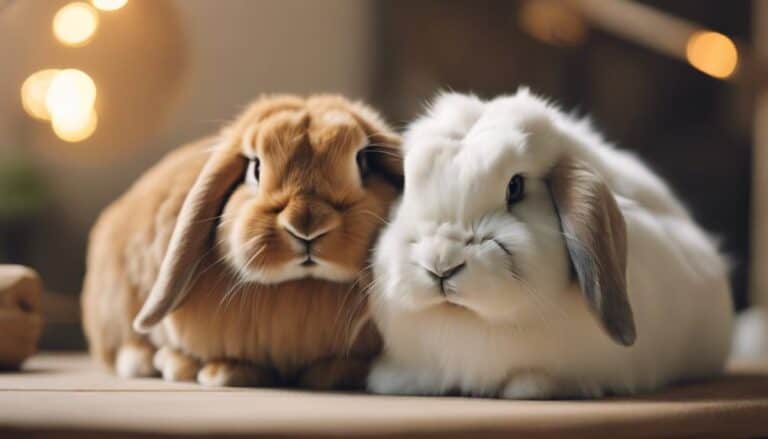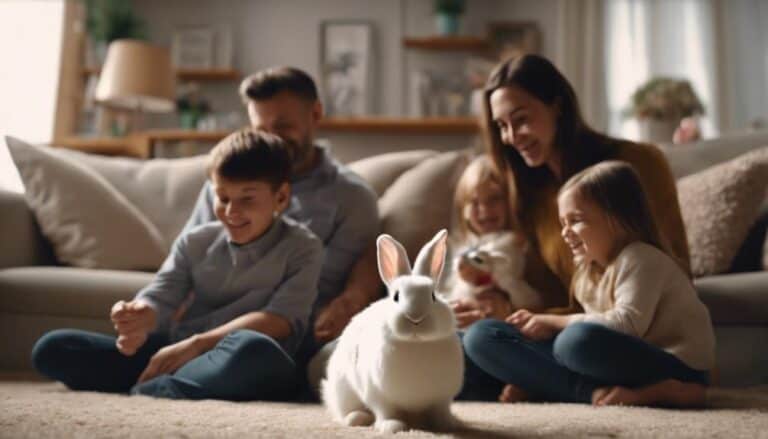To provide a comfortable living environment for your adult rabbit, you need to provide adequate space. This is essential for their well-being.
The hutch itself needs to meet specific dimensions. But that's not all – you also need to think about the exercise area. Rabbits need room to move around and stretch their legs.
Proper space doesn't just affect their physical health. It also affects their mental stimulation. If your rabbit doesn't have enough space, they can get bored, stressed, or even depressed.
So, before you set up your rabbit's home, it's crucial to understand their space needs. This will guarantee their happiness and overall quality of life.
Contents
Key Takeaways
So, you're wondering how much space your adult rabbit needs in its home?
A good rule of thumb is to provide a minimum of 12 square feet of living space for your rabbit. When it comes to the hutch, it should be at least 2 feet wide for smaller to medium breeds and 3 feet wide for larger breeds.
The length of the hutch is also important – it should allow your rabbit to take 3-4 hops without obstruction. This will give them enough room to move around comfortably.
But living space is just the beginning. Your rabbit also needs exercise space to stay happy and healthy. Aim to provide a minimum of 32 square feet of exercise space for your rabbit to run around and play.
Another way to think about it is to consider the enclosure guidelines, which suggest at least 10 square feet of living space, or about three times the rabbit's length. By following these guidelines, you can create a comfortable and happy home for your rabbit.
Minimum Space Requirements
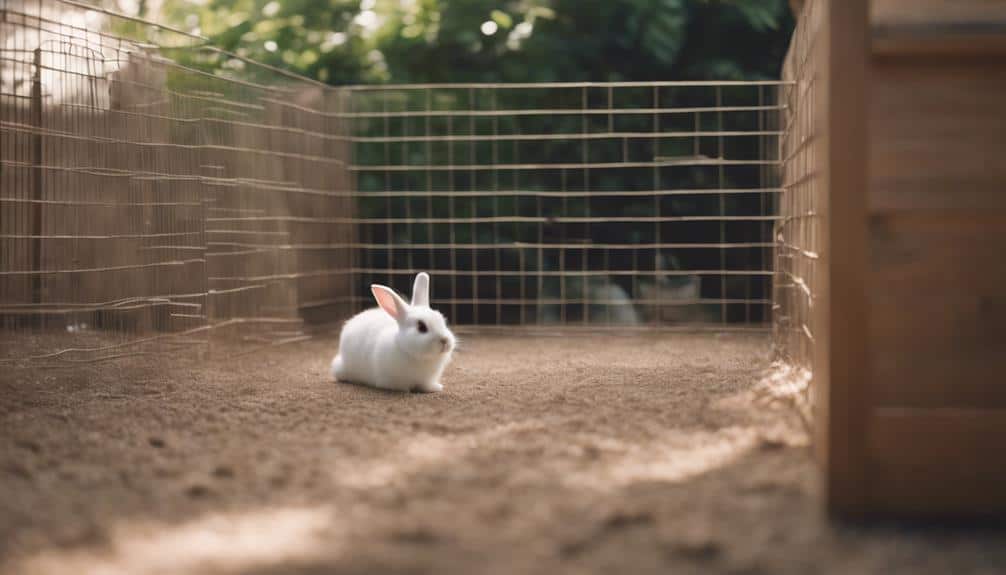
So, you want to make sure your adult rabbit is happy and healthy, right?
One crucial thing to get right is the space they need to live comfortably. A good rule of thumb is to provide at least 12 square feet of living space for your rabbit. This should include an enclosed sleeping area, a litter tray, food and water bowls, and some toys to keep them entertained.
The rabbit hutch itself should be a certain size, depending on the breed of your rabbit. For smaller to medium-sized breeds, the hutch should be at least 2 feet wide. For larger breeds, it's best to go with a hutch that's at least 3 feet wide.
The length of the hutch is also important. You want to make sure your rabbit has enough room to move around comfortably. A good test is to make sure they can take 3-4 hops without bumping their nose into anything. For medium-sized rabbits, that's about 18 inches per hop.
The height of the hutch is also crucial. You want your rabbit to be able to stand up comfortably on their back legs. For smaller breeds, a hutch that's at least 2 feet tall should do the trick. For larger breeds, you'll want a hutch that's at least 3 feet tall.
But the hutch is just the beginning. Your rabbit also needs plenty of exercise space to stretch, stand up fully, jump around, and interact with objects. Aim for at least 32 square feet of exercise space to keep your rabbit happy and healthy.
Hutch Dimensions for Comfort
When designing a rabbit hutch, it's essential to provide ample space for your furry friend to move around comfortably.
The hutch should be tall enough for your rabbit to stand on its back legs without hunching.
For small breeds, a minimum height of 2 feet is recommended, while larger rabbits need at least 3 feet of clearance.
The width of the hutch is also crucial.
Small to medium rabbits need at least 2 feet of width, while large to giant breeds require a minimum of 3 feet.
The length of the hutch is just as important.
It should be long enough for the rabbit to take 3-4 hops without obstruction, allowing for natural movement.
Aim for a living space of at least 12 square feet, which should include areas for rest, food, water, and playthings.
Your rabbit should have room to hop, stand comfortably, and lie down and stretch within its hutch.
Providing adequate space is essential for the well-being and happiness of your small animal, guaranteeing proper animal care and promoting a healthy environment.
Enclosure Guidelines for Rabbits
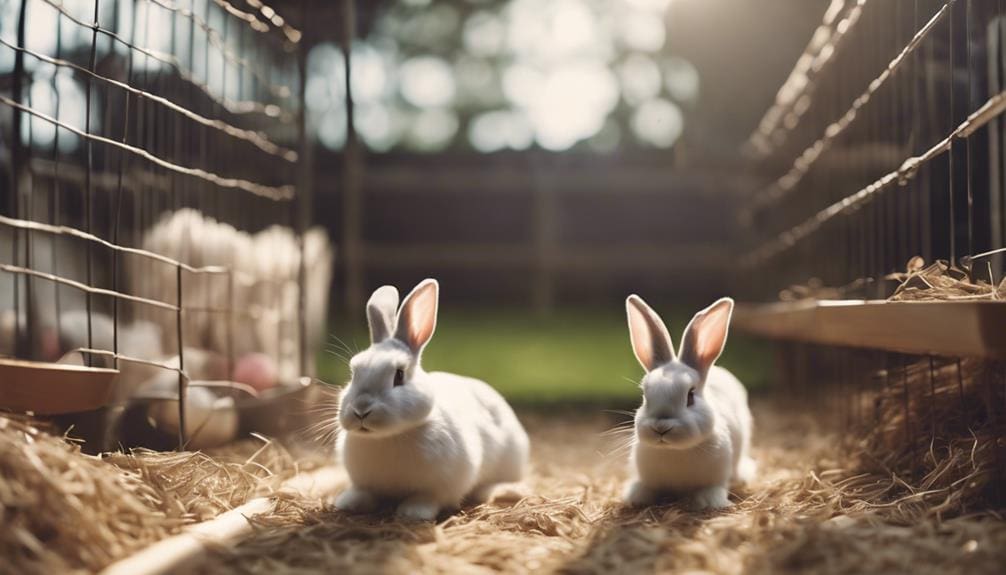
When it comes to enclosure guidelines for rabbits, one crucial thing to keep in mind is that the living space should be at least 10 square feet. A good rule of thumb is to provide an enclosure that's about three times the length of your rabbit and one and a half to two times their width. This will give them plenty of room to move around and get comfortable.
The height of the enclosure is also important. Your rabbit should be able to stand on its hind legs, so the enclosure should be at least 18-24 inches tall. A cage that's at least 2x3x4 feet is a good starting point, as it provides enough space for your rabbit to exercise and explore.
But don't just stop at the minimum requirements. It's really important to give your rabbit a habitat that lets them get some physical activity and mental stimulation. If possible, try to provide a larger cage – one that's double the width of your rabbit and four times their length.
This will really help improve their well-being. By giving your rabbit a spacious enclosure, you're creating an environment that lets them thrive and live a happy, healthy life.
Exercise Space Recommendations
Dedicate a space in your home for your adult rabbit to exercise and have fun. Rabbits need room to live and play, so aim for a large area where they can run and jump freely.
At the very least, provide an exercise pen or a designated space where your rabbit can move around comfortably.
This space should be big enough for your rabbit to stand on its hind legs without hitting its head on the ceiling. This allows them to stretch their legs and stay active. By providing a suitable exercise area, you're helping your rabbit maintain a healthy lifestyle and preventing boredom.
Watching your rabbit in this space can also give you a better understanding of their behavior and preferences. This allows you to tailor their living environment to their specific needs, ensuring they've the best possible quality of life.
Accommodating Multiple Rabbits
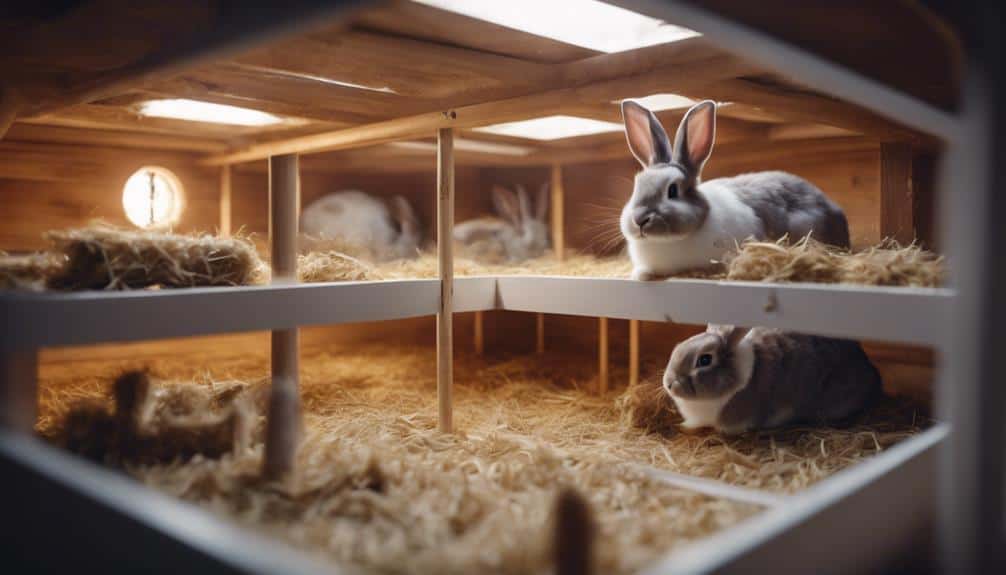
So, the key to accommodating multiple rabbits in your home is to make sure each rabbit has enough space to move around comfortably and engage in natural behaviors. According to the Rabbit Code of Practice, each rabbit needs a living area that allows them to stretch, hop, and explore.
When you’re housing multiple rabbits, it’s vital to provide them with ample space to prevent territorial disputes and promote their well-being. A spacious environment allows them to roam freely, exercise, and engage in natural behaviors, which is crucial for their mental and physical health. When considering how many rabbits per acre, it’s important to ensure that each rabbit has enough room to thrive, ideally allowing for at least 100 square feet of space per rabbit in a well-managed area. This setup not only keeps them happy but also reduces stress and conflicts among the group.
One way to do this is to give each rabbit their own small cage or hutch within a larger shared living area. This setup allows for individual privacy while still promoting social interactions.
Each rabbit should have access to a minimum of 12 square feet of living space, but more room is always beneficial.
On top of that, having multiple rabbits in a shared space requires providing various hiding spots, toys, and enrichment activities to prevent boredom and encourage exercise. This is crucial for safeguarding their mental and physical health.
Conclusion
Giving your adult rabbit enough space in its home is crucial for its overall well-being and happiness. A rabbit that has enough room to move around is more likely to be happy and healthy.
So, how much space does your rabbit need? The minimum recommended amount of living space is 12 square feet. This will give your rabbit enough room to stretch out, move around, and engage in normal rabbit behavior.
In addition to living space, your rabbit also needs a comfortable hutch and plenty of exercise space. A hutch provides a safe and cozy place for your rabbit to rest, hide, and feel secure. Exercise space is important because rabbits need to move around and get some physical activity to stay healthy.
By providing your rabbit with enough space, a comfortable hutch, and plenty of exercise opportunities, you can help keep your furry friend healthy and happy.




